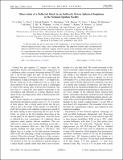Observation of a Reflected Shock in an Indirectly Driven Spherical Implosion at the National Ignition Facility
Author(s)
Le Pape, S.; Divol, L.; Berzak Hopkins, L. F.; Mackinnon, A. J.; Meezan, N. B.; Casey, Daniel Thomas; Herrmann, H.; McNaney, J.; Ma, T.; Widmann, K.; Pak, A.; Grimm, G.; Knauer, J.; Kilkenny, J. D.; Frenje, Johan A.; Petrasso, Richard D.; Zylstra, Alex Bennett; Rinderknecht, Hans George; Rosenberg, Michael Jonathan; Gatu Johnson, Maria; ... Show more Show less
DownloadPhysRevLett.112.225002.pdf (884.4Kb)
PUBLISHER_POLICY
Publisher Policy
Article is made available in accordance with the publisher's policy and may be subject to US copyright law. Please refer to the publisher's site for terms of use.
Terms of use
Metadata
Show full item recordAbstract
A 200 μm radius hot spot at more than 2 keV temperature, 1 g/cm[superscript 3] density has been achieved on the National Ignition Facility using a near vacuum hohlraum. The implosion exhibits ideal one-dimensional behavior and 99% laser-to-hohlraum coupling. The low opacity of the remaining shell at bang time allows for a measurement of the x-ray emission of the reflected central shock in a deuterium plasma. Comparison with 1D hydrodynamic simulations puts constraints on electron-ion collisions and heat conduction. Results are consistent with classical (Spitzer-Harm) heat flux.
Date issued
2014-06Department
Massachusetts Institute of Technology. Department of Physics; Massachusetts Institute of Technology. Plasma Science and Fusion CenterJournal
Physical Review Letters
Publisher
American Physical Society
Citation
Le Pape, S., L. Divol, L. Berzak Hopkins, A. Mackinnon, N. B. Meezan, D. Casey, J. Frenje, et al. “Observation of a Reflected Shock in an Indirectly Driven Spherical Implosion at the National Ignition Facility.” Physical Review Letters 112, no. 22 (June 2014). © 2014 American Physical Society
Version: Final published version
ISSN
0031-9007
1079-7114